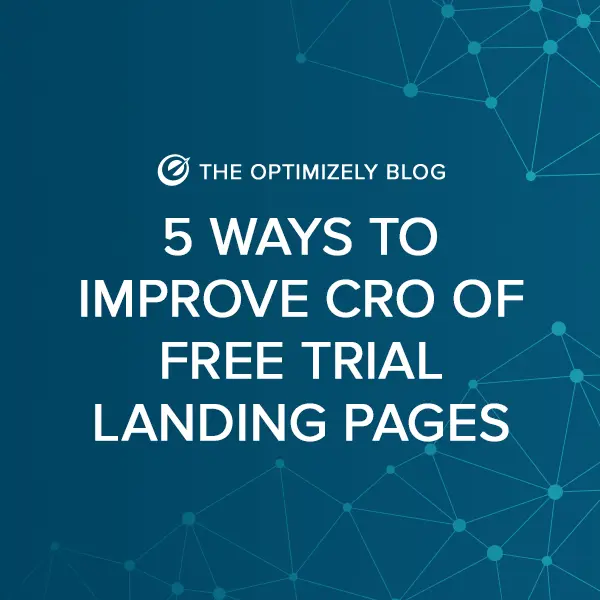5 ways to improve the CRO of free trial landing pages
When you’re trying to get people to spend on your service, it’s hard to imagine there’s anything more persuasive than a money-back guarantee.

Kevin Lynch

But, according to an experiment run by one of the world’s most well-known marketers, it’s at best the second-most compelling thing you can offer.
The test
When Neil Patel’s website, QuickSprout.com, reached 400,000 monthly unique visitors, his focus was no longer on boosting traffic, but on increasing purchases of his Quick Sprout Traffic System.
One of two ways to do that, he found, was by adding a money-back guarantee to the $197 offer. Ultimately it would boost monthly revenue by an impressive 21%.
The second way, though, was even more profitable. This time, he let people try his system before they bought it — and monthly revenue shot up by over $4,000 — a 24% increase.
Results like these, while impressive, shouldn’t surprise any of us. Even more than seeing a product or service in action, people like to experience it.
Netflix was built on free trial subscriptions, and 73% of people who trial Amazon Prime convert to paying customers.
As effective as they can be, though, there are still some barriers preventing your prospects from signing up for your free trial. Just because they’re free doesn’t mean they’re easy to give away.
Are you trustworthy? Is their credit card information secure? Is your service even worth taking for a spin?
To relieve your prospects’ doubts, you’ll need a highly persuasive landing page. On a free trial landing page, in particular, that action is “sign up,” but it can also be to buy, subscribe, download, etc.
Some of the elements you’ll use to convince your visitors to sign up for your free trial — like social proof and benefit-oriented copy — are essential on all landing pages. Some, though, are more important on free trial landing pages than any other.
To determine the best combination of elements on yours, consider experimenting on the following elements:
1. Test different layouts
When Investopedia sought conversion optimization help from the team at MarketingExperiments, they were generating conversions at a respectable rate — but they wanted more.
So, they conducted a “ variable cluster test,” meaning, they changed a lot of page elements between their original and test page. The variation featured a different headline, a new call-to-action, and copy written in the style of a letter on behalf of the co-founder.
Here’s the original:

And here’s the much longer variation:

The longer, letter-style page boosted conversion rates by nearly 90%!
Though this might seem like it opposes conventional wisdom (nobody has time to read your long page), when an offer is more complicated or it requires a higher level of commitment from the visitor, a more comprehensive page can actually boost conversions. In those cases, your offer will be met with more scrutiny.
If your service is fairly straightforward, though, your page might not need to be so content-heavy. Less was more for another MarketingExperiments client, whose page was de-cluttered by removing verbose copy, along with images that didn’t support the sales message.
At the end of the test, that shorter page boosted conversions by over 178%. Overall, the type of layout you choose will depend on your offer.
2. Test different types of media
When your service has the potential to be highly scrutinized, more content isn’t always the answer. Sometimes, what you need is a different type of content.
Instead of adding copy, try substituting video. Because of its ability to speak to a reader in a familiar way, video has been shown to boost conversions by up to 86% on landing pages.
Try using the medium to explain how your service solves a problem, introduce a high-level executive in your company, or showcase what your software looks like on the inside.
But if you add educational content like this, do so with caution, warns Marketing Consultant Geoffrey Walters:
“Don’t do too much spoon-feeding in terms of the info you’re presenting. True evaluators have often done a lot of research and intros or explainer videos at the signup stage can actually increase friction for this group. Make sure you at least have an option to skip that step so that true evaluators can get started right away.”
3. Test a multi-step conversion process
Everybody understands the panic that sets in when you see a credit card field on a page that’s offering something for free. To keep your prospects from immediately abandoning your page at the sight of a form labeled “Payment Information,” try separating the conversion process into multiple steps.
Collect necessary information first, like name and email, then ask for credit card information on the next page.
You may find this works, or you may find that you’re generating a higher volume of less qualified leads. If that’s the case, consider the bold change Trunk Club made to their conversion flow by asking for payment information up front.

The change helped them separate window shoppers from serious buyers, which ultimately led to fewer, but higher-quality conversions.
“We saw about half as many trunk requests come through—but then we were twice as likely to actually convert those trunk requests [to shipments],” said Justin Hughes, Director of Product at Trunk Club.
At what point in the journey you ask for payment info will depend on what you’re trying to accomplish. Are you okay with nurturing window shoppers to sale, or do you only want to generate conversions from serious buyers?
4. Test security badges to let prospects know they’re safe
If you’re going to make your prospects input sensitive information like their credit card number on your free trial landing page, it’s nearly always a good idea to display badges from well-known security companies next to your form to let visitors know they’re protected.

Joann.com and Orientalfurniture.com boosted conversions by 5.5% and 7.6% respectively after adding such badges to their pages. However, their presence doesn’t always guarantee a conversion lift.
WiderFunnel notes an instance in which they actually decreased conversions for a client by 1.6%.
How could that happen?
“The hypothesis: security badges create anxiety in website visitors who may not have been focused on security initially,” says Shana Rusonis, Product Marketing Manager at Optimizely.
In other words, the sight of these security badges, in some cases, can remind visitors that their information perhaps wasn’t safe in the first place.
5. Collect feedback to improve the process
The best way to improve your free trial landing page is to learn from your mistakes. If people are abandoning your page, don’t guess why. Instead, find out from the source directly, like Moz did with the help of Conversion Rate Experts.
Here’s how they did it, per the team:
- We asked paying members what they liked most about the Moz service, what ultimately convinced them to sign up, and how they would describe the service to a friend (among many other questions).
- Next, we asked non-paying (free trial) members many questions, including what would make them sign up for the service, which tools they liked the most and the least, and what their most time-consuming SEO tasks were.
- Then, we talked with paying members who had canceled, asking them the obvious question: “Why did you cancel?” We also wanted them to tell us the one thing that would bring them back.
Among other techniques, they even asked visitors to take part in usability testing the new pages, which were designed based on visitor feedback.
Ultimately, the Conversion Rate Experts were able to boost revenue for Moz by $1 million.
Take a page out of their book by learning from your prospects and other businesses to improve your free trial landing page conversion rate.
